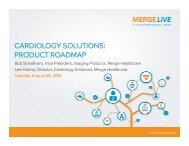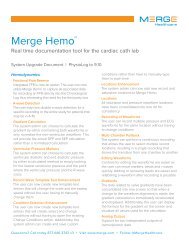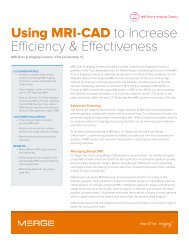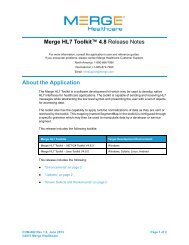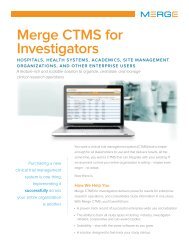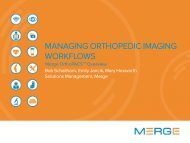INVESTOR PRESENTATION - Merge Healthcare
INVESTOR PRESENTATION - Merge Healthcare
INVESTOR PRESENTATION - Merge Healthcare
You also want an ePaper? Increase the reach of your titles
YUMPU automatically turns print PDFs into web optimized ePapers that Google loves.
Enemy NPC Design Patterns in Shooter GamesGabriel Rivera, Kenneth Hullett, Jim WhiteheadAugmented Design LabUniversity of California, Santa CruzSanta Cruz, CA 9506gaariver@ucsc.edu, {khullett, ejw} @soe.ucsc.eduABSTRACTGameplay in single-player shooter games primarily consists ofcombat with Non-player Characters (NPCs). However, there hasbeen little research done to study how enemy NPCs affect playerbehavior in shooter games. As a consequence, there is no formallanguage for designers to discuss how NPCs are used in shootergames. This paper presents design patterns for NPCs in shootergames and explores their effects on gameplay. These patterns helpdesigners communicate about and explore new ideas for enemyNPCs and further our understanding about how NPC types can beimplemented, enabling more engaging experiences.1. INTRODUCTIONThe analysis presented here is based on commercially-availablegames in the shooter genre. Shooter games allow players totraverse expansive, 3-dimensional spaces where they interact withthe environment and other entities primarily through combat.This research is focused on the enemy NPCs that populate a givenlevel. Enemy NPCs are controlled by the computer and are themain source of conflict during gameplay. NPCs are one of theelements a designer can use to craft the pacing, challenge, andtension of a level. Designers can control not only where the NPCis placed but also the NPC’s scripted behavior, how they areequipped, their level of health, their level of armor, and othervariables.Designers consider all of these factors when creating a level.There may be a terminology that many designers can use in orderto talk about this; for-instance people can reference boss battles orother encounters. However, there is currently no cataloguedlanguage with a consistent terminology that can be used fordescribing these concepts. Design patterns help solve this problemby creating a consistent terminology that can be referenced bypeople in the field. This results in people being able tocommunicate high level, overarching concepts faster to each otherwhen design challenges come up. These concepts should beproven patterns that people know will work and that can bepassed down to people newer to the field. By having definedpatterns, it creates a lower barrier to entry for more complicatedconcepts to newer people in the field because there is a now aterminology that can be referenced and studied. Furthermore,patterns can help to explore new ideas when viewing a designchallenge through all the different patterns. Overall, theintroduction of design patterns to enemy NPC types would help tofoster a more creative environment by allowing for clearercommunication across designers of all levels.For this research we explored elements that pertain to all NPCswithin the shooter genre and then analyzed various games to see ifNPCs consistently fell into patterns. Patterns were identified byobserving NPC behavior and discerning which elements werecombined in the same way within a number of games. Eachpattern is accompanied by our observations about how it’s usedby designers to create gameplay, as well as a list of elements thatdefine the pattern.The primary contribution of this work is to create a commonvocabulary for the different types of NPCs found in shooter gamesin order to label the different relationships that these NPCs havewith the game play of the level. Through these patterns, a basicframework should be set for designers to collaborate and work offof in order to create better experiences for the player.2. RELATED WORKSThere are two main fields of study that pertains to this research:design patterns and level design. The concept of creating aformalized language to describe a field was pioneered byChristopher Alexander in his book “A Pattern Language” [1]. Thebook revolved around architecture and how you could create aformalized language for how to approach architectural structuresby classifying them as different patterns that were organized bytheir function, detailing how to solve each one. This was thenexpanded into the field of computer science in order to approachproblems when organizing programs, as detailed in DesignPatterns: Elements of Reusable Object - Oriented Software [3].The concept of design patterns and how they relate to games hasbeen explored by other sources. The first instance of this wasBjörk and Holopainen’s Patterns in Game Design, which was thefirst foray into investigating how patterns were applied to themedium. As games research has expanded other people havebegun looking at more specific patterns in game design. Hullettand Whitehead’s Design Patterns in FPS Levels [5] investigatespatterns in level design and how it affects a player’s experience ofthe game. The patterns represented in this paper do affect NPCsand are mentioned briefly in section 6. However, due to timeconstraints it wasn’t feasible to extensively examine how theseLevel Design Patterns (LDPs) affected the NPC patterns presentedin this paper.Other people have examined how NPCs affect a player’sexperience during combat. Mike Birkhead investigates NPCswithin combat in Tips from a combat designer: The art of bossdesign, which examines the idea of boss encounters and how todesign a NPC to fit one. Benson Russell’s A Deeper Look IntoThe Combat Design of Uncharted 2 also investigates designingcombat in the shooter genre with a small emphasis on NPCinteraction. However these articles do not apply patterns to NPCdesign or combat within shooters. They examine the overalldesign and dissect what happens in games but don’t try to developa large language that can be used to communicate concepts toother designers with.
forward looking statement2The matters discussed in this presentation may include forward-looking statements, whichcould involve a number of risks and uncertainties. When used in this presentation, the words“will,” “believes,” “intends,” “anticipates,” “expects” and similar expressions are intendedto identify forward-looking statements. Actual results could differ materially from thoseexpressed in, or implied by, such forward-looking statements. Except as expressly requiredby the federal securities laws, the Company undertakes no obligation to update such factorsor to publicly announce the results of any of the forward-looking statements. Some of theproducts and/or product features discussed in this presentation may be works in progressand not yet generally available for sale.
about <strong>Merge</strong> <strong>Healthcare</strong>Traded on NASDAQ Exchange (MRGE)Over 750 employees worldwideRevenue guidance of $235M for FY11 compared to$140 for FY10 (GAAP)/$190M Pro Forma2011 Market Cap between $286M - $504M(1/05/2011 vs. 5/10/2011)Co-founder and #1 provider of DICOM solutionsglobally
what we do4any image. anywhere. any time.We develop information technology to create a betterelectronic healthcare experienceOur solutions range from standards-baseddevelopment toolkits to sophisticated clinicalapplicationsWe can image-enable any existing “ologies” or “-ographies”Our solutions have been used by leading healthcareproviders, vendors and researchers worldwide forover 20 years
our clients5Over 1,500 Hospitals: Including the top 20 hospitalson the US News and World Report “America‟s BestHospitals Honor Roll”4,000 Clinics and Labs: Representing one-third ofU.S. imaging centers, nearly half of all digital orthogroups and over 1,200 labs250 OEM Clients: Including the leading modalitymanufacturers and distributors70% of top pharma companies
our global offices6
our executive team7Michael FerroChairmanJustin DearbornCFOSteve BrewerEVP, Product SolutionsNancy KoenigEVP, OperationsJeff SurgesCEOToni WellsEVP, DevelopmentSteve MartinSVP, Global SalesDr. Cheryl WhitakerChief Medical Officer
medical images are the youtube of healthcare1080% of the data storage in healthcare comesfrom medical imagesAn average diagnostic image of the heart is thesame size (3 GB) as the video file for the movie,TitanicThe technology that enables secure web imagesharing is very expensive to build and operateHealth records are incomplete if they do notcontain images
"The needs of radiology must beaddressed in any nationalinfrastructure in order to accomplishthe broader goal of providing the bestpatient care possible.“Keith Dreyer, DO, PhDRSNA's RadLex Steering CommitteeChair of the American College of Radiology IT and Informatics Committee-Government Relations Subcommittee
“The role of imaging as a meaningfuluse aspect raises a number ofimportant and interesting issues. Wecan‟t have an effective electronichealth information system if we can'tmove images.“David Blumenthal, MDformer National Director for Health Information Technology
addressable market for our current portfolio13Meaningful Use(Radiology &Ortho)*$2BUS Imagingsoftware &services*$1BGlobal (non-U.S.)imaging software& services$1BInteroperability –NA healthcare ITsoftware &services**$1Bannual market size annual market size annual market size annual market sizeInteroperability –global healthcareIT software &services$2BDigital Pathology(total marketopportunity)$1BImaging inClinical Trials$.5annual market size annual market size annual market sizeTOTAL ANNUALMARKETOPPORTUNITY$85B* Total Stimulus Funding Available** Source: Frost & Sullivan
our solutions14<strong>Merge</strong> iConnect: Image and health datainteroperability platformClinical Solutions: Imaging and informationsolutions for radiology, cardio, ortho, surgical,anesthesia & labImage Toolkits & Device Connectivity:Provider of 85% of DICOM solutions tomodality vendors and health system deviceintegrationConsumer Engagement: Patient kiosk andemerging consumer opportunities
consumer engagement:public access via merge kiosks16Full-service live remote help via multi-lingual avatarsCreate an accountTake your vitalsUse a physician locator and print directions forappointmentDetermine eligibility and health insurance optionsUpload your historical records
ecent highlights17<strong>Merge</strong> <strong>Healthcare</strong> to Acquire Ophthalmic ImagingSystems (June 6, 2011)Center for Diagnostic Imaging Partners with <strong>Merge</strong><strong>Healthcare</strong> to meet Meaningful Use Requirements(May 3, 2011)<strong>Merge</strong> Leads $1B Stimulus Funding Opportunity forRadiologists (April 13, 2011)<strong>Merge</strong> <strong>Healthcare</strong> Appoints Dr. Cheryl Whitaker asChief Medical Officer (April 8, 2011)Elmhurst Memorial <strong>Healthcare</strong> Selects <strong>Merge</strong>Cardiology Solutions For New Facility (April 1, 2011)<strong>Merge</strong> <strong>Healthcare</strong> Expands Capabilities In RevenueCycle Management (March 9, 2011)
emerging trends18Meaningful UseOur core solutions in Radiology andOrtho will quality for Meaningful UseCertificationEnterprise Wide ImagingHealth systems are moving away fromdepartmental solutions to enterprisewisestrategies for imagingArchiving GrowthFor many health systems, medical imagesare the largest and fastest growing elementof storage growthSpendingpredicted toDOUBLE*InteroperabilityInteroperability is required to addressMeaningful Use, ACOs, and bundledpaymentsHIEsHealth Information Exchanges area vital for the industry's successwith ARRA* Bain & Company survey
growth strategies19Cross Sell & Upsell Current Clients› Cardiology & Radiology – two largest imagingspecialties› Archive, Interoperability and Connectivity› Average client has only 1 <strong>Merge</strong> solutionMeaningful Use› Achieve Phase 1 for clients› Prepare for Phase 2 and 3› Expand EMR portfolioInternational ExpansionState and Federal Opportunities
client conference: <strong>Merge</strong>LIVE20What:<strong>Merge</strong> Client ConferenceWhen: Tuesday, Oct 4 – Friday, Oct 7Who:400+ <strong>Merge</strong> clientsWhere: ChicagoWhy:• Upsell and cross sell current clients• Generate new leads among client base• Nurture current pipeline opportunities• Educate and share best practices• Build affinity for <strong>Merge</strong> brandThis is one of the single biggest marketing and sales opportunities of 2011!
FINANCIAL HIGHLIGHTSJustin DearbornMay 2011
full year income statement 2008 2009 201022Years Ended December 31,2010 2009 2008Net sales:Software and other $ 42,420 $ 33,037 $ 27,561Professional services 23,175 11,830 8,586Maintenance and EDI 74,737 21,974 20,588Total net sales 140,332 66,841 56,735Cost of sales:Software and other 13,762 3,730 5,121Professional services 15,411 6,731 6,044Maintenance and EDI 24,418 5,593 5,628Depreciation, amortization and impairment 10,972 3,323 3,279Total cost of sales 64,563 19,377 20,072Gross margin 75,769 47,464 36,663Operating costs and expenses:Sales and marketing 20,697 9,203 9,313Product research and development 20,064 10,689 13,240General and administrative 22,012 13,005 20,461Acquisition-related expenses 9,674 1,225 -Trade name impairment, restructuring and other expenses 5,006 1,613 11,816Depreciation, amortization and impairment 6,840 2,766 3,530Total operating costs and expenses 84,293 38,501 58,360Operating income (loss) (8,524) 8,963 (21,697)Other income (expense):Interest expense (17,218) (2,716) (1,750)Interest income 58 50 268Other, net 522 (6,147) (564)Total other income (expense) (16,638) (8,813) (2,046)Income (loss) before income taxes (25,162) 150 (23,743)Income tax benefit (13,646) (135) (60)Net income (loss) $ (11,516) $ 285 $ (23,683)Less: preferred stock dividends 19,076 - -Net income (loss) available to common shareholders $ (30,592) $ 285 $ (23,683)Net income (loss) per share - basic $ (0.38) $ 0.00 $ (0.51)Weighted average number of common shares outstanding - basic 80,231,427 60,910,268 46,717,546Net income (loss) per share - diluted $ (0.38) $ 0.00 $ (0.51)Weighted average number of common shares outstanding - diluted 80,231,427 62,737,821 46,717,546
proforma p&l trend: past four quarters236054.05047.851.14041.530Q2 2010Q3 2010Q4 201020Q1201114.513.313.2104.46.27.110.03.22.37.70-10Pro Forma Revenue Operating income Adjusted net income Adjusted EBITDA(6.8)(4.2)
evenue snapshotRevenue consists of perpetual software licensesand sale of hardware* and professional services andmaintenance**Non Recurring Revenue› Includes perpetualsoftware licenses,hardware, andprofessional services› Non-recurring backlog$42.3 Q1 „11Non Recurring35%Recurring65%Recurring Revenue› Includesmaintenancecontracts***› SaaS offering,DICOM toolkit andEDI* Recognized upon delivery** Recognized over respective periods services are provided*** Renewed annually
strategic investmentsR&D CommitmentsSales Commitments› 70 issued Patents› Research & Development represents 13% of our total › spend Sales in Q1 & Marketing represents 17% of our total2011spend in Q1 2011› Sales force grown from 60 to 10013%17%
alance sheet and cash flow26$47.7M Cash$200.0M DebtYear Ended December 31,(unaudited) 2010 2009 2008(in millions)Cash received from (paid for):Issuance of debt and equity $ 236.3 $ 25.2 $ 14.5Principal payments on notes - (19.6) -Interest expense (11.9) (1.9) (1.0)Early retirement penalty on debt - (2.7) -Debt and equity issuance costs (9.9) - (2.4)Acquisitions (216.2) (2.8) -Restructuring initiatives (3.5) (1.9) (5.5)Acquisition related expenses (9.6) (1.2) -Property and equipment purchases (1.5) (1.1) (0.5)Sale of property 6.1 - -Other non-operating cash flows 0.6 0.9 0.5Core business operations 29.9 6.9 (2.0)Increase in cash $ 20.3 $ 1.8 $ 3.6Three Months Ended March 31,2011 2010(unaudited)(amounts in millions)Cash received from (paid for):Acquisitions $ - $ (1.4)Restructuring initiatives (0.6) (0.4)Acquisition related costs (0.4) (4.9)Preferred stock deposits, net of escrow - 4.3Debt and equity issuance costs - (1.6)Property and equipment purchases (0.3) (0.6)Settlements with former officers (0.9) -Core business operations 8.9 0.8Increase (decrease) in cash $ 6.7 $ (3.8)
2011 financial guidance27<strong>Merge</strong> has provided 2011 guidance as follows:RevenueEBITDA25025%20020%15010050$190M$235 -$240M15%10%5%25%23%2010Actual2011Guidance2010Actual2011Guidance
our sustainable competitive advantage28Leading “pure play” company specializing inimagingDiagnostic content and results are the cornerstonefor the interoperability, hosting, and archivingmarketsInteroperability solutions for diagnostic content andresults are essential to deliver a complete healthrecordBusiness model and technology innovation such asCAD, interoperability and cloud solutionsWe are at the beginning of what we expect will bethe fastest transformation of any industry in UShistory
investment highlights29Significant GrowthRevenue guidance of $235M163% YOY Top line growth135% YOY EBITDA growthFavorable MacroIndustry ConditionsEconomic and government environment are driving changeMeaningful Use will help to accelerate demandRevenue VisibilityHigh recurring revenue modelLarge, diversified client baseStrong, SeasonedLeadershipDeep management team with extensive healthcareexperienceTrack record for making and integrating acquisitions
APPENDIXMay 2011
appendix: non GAPP reconciliation31Pro Forma Three MonthsEnded March 31,2011 2010Net loss available to common shareholders $ (1,890) $ (1,130)Acquisition related costs 104 255Restructuring and other (36) -Stock-based compensation expense 1,062 354Amortization ofsignificantacquisition intangibles 3,088 2,432Adjusted net income (loss) $ 2,328 $ 1,911Depreciation and amortization 2,061 2,545Net interest expense 6,354 6,558Non-cash preferred stock dividend 1,566 1,566Income tax expense (benefit) 845 94Adjusted EBITDA $ 13,154 $ 12,674Adjusted net income (loss) per share - diluted $ 0.03 $ 0.02Adjusted EBITDA per share - diluted $ 0.15 $ 0.15Fully diluted shares (if net income) 86,391,245 84,023,293
appendix: non GAPP reconciliation32Three Months EndedMarch 31,2011 2010Net loss available to common shareholders $ (3,155) $ (3,152)Acquisition related costs 104 5,938Restructuring and other (36) -Stock-based compensation expense 1,062 354Amortization of significant acquisition intangibles 3,088 501Acquisition-related sales adjustments 1,337 328Acquisition-related cost of sales adjustments (72) -Adjusted net income $ 2,328 $ 3,969Depreciation and amortization 2,061 1,557Net interest expense 6,354 (10)Non-cash preferred stock dividend 1,566 -Income tax expense (benefit) 845 48Adjusted EBITDA $ 13,154 $ 5,564Adjusted net income per share - diluted $ 0.03 $ 0.05Adjusted EBITDA per share - diluted $ 0.15 $ 0.07Fully diluted shares (if net income) 86,391,245 76,508,293
footnotes regarding 2011 financial guidance33Amortization & depreciation in cost of goods sold ofapproximately 10.5 million, of which 7.5 millionrelates to the amortization of intangibles fromsignificant acquisitionsApproximately 8 million of depreciation andamortization within operating expenses, of which 5million relates to the amortization of intangibles fromsignificant acquisitionsApproximately 26 million of interest expense(including the amortization of debt issuance anddebt discount costs)A non-cash preferred stock dividend ofapproximately 7 millionApproximately 3 million of non-cash stock-basedcompensation expenseMinimal impact to expense for income taxes (maybea few million, primarily non-cash expense related tothe Canadian operations)
explanation of non-GAPP financial measures34<strong>Merge</strong> <strong>Healthcare</strong> reports its financial results in accordance with generally accepted accounting principles, or GAAP.This press release includes certain non-GAAP financial measures to supplement its GAAP information. Non-GAAPmeasures are not an alternative to GAAP and may be different from non-GAAP measures used by other companies. Aquantitative reconciliation of GAAP net income available to common shareholders to adjusted net income and adjustedEBITDA is included after the financial information included in this press release.Management believes that the presentation of non-GAAP results, when shown in conjunction with correspondingGAAP measures, provides useful information to it and investors regarding financial and business trends related toresults of operations, because certain charges, costs and expenses reflect events that are not essential to recurringbusiness operations. In addition, management believes these non-GAAP measures provide investors usefulinformation regarding the underlying performance of the post-acquisition business operations when compared to thepre-acquisition results of <strong>Merge</strong> and any significant acquired company. Purchase accounting adjustments made inaccordance with GAAP can make it difficult to make meaningful comparisons of the underlying operations of thebusiness without considering the non-GAAP adjustments that are provided and discussed herein. Further,management believes that these non-GAAP measures improve its and investors‟ ability to compare <strong>Merge</strong>‟s financialperformance with other companies in the technology industry. Management also uses financial statements thatexclude these charges, costs and expenses for its internal budgets. While GAAP results are more complete, thesesupplemental metrics are offered since, with reconciliations to GAAP, they may provide greater insight into our financialresults. Management does not intend the presentation of these non-GAAP financial measures to be considered inisolation or as a substitute for results prepared in accordance with GAAP.Additional information regarding the non-GAAP financial measures presented is as follows:Pro forma revenue consists of GAAP revenue as reported, adjusted to reflect the acquisition of AMICAS as if it hadoccurred at the beginning of the respective periods presented and to add back the acquisition related salesadjustment (for all significant acquisitions) booked for GAAP purposes.
explanation of non-GAPP financial measures cont.35Recurring revenue is generated from agreements that generally contain a stated annual amount and which we have a highlikelihood of renewing each year. More specifically, this includes revenue generated from our DICOM toolkit and eFilmWorkstation® product lines, long-term contracts associated with our Sales as a Service (SaaS) related offerings, and EDIand maintenance contracts across the entire business.Non-recurring revenue backlog represents revenue that we anticipate recognizing in future periods from signed customercontracts as of the end of the period presented. Non-recurring revenue is comprised of all other sources of revenue notincluded as recurring revenue, primarily from perpetual software licenses, hardware and professional services (includinginstallation, training and consultative engineering services).Adjusted net income consists of GAAP net income available to common stockholders, adjusted to reflect the acquisition ofAMICAS as if it had occurred at the beginning of the respective period presented and, to the extent such items occurred inthe periods presented, excludes (a) one-time preferred stock deemed dividend at issuance date, (b) one time income taxbenefit, (c) impairment of investments, (d) sale of non-core patents, (e) acquisition-related costs, (f) restructuring and othercosts, (g) stock-based compensation expense, (h) acquisition-related amortization, and (i) acquisition-related cost of salesadjustments and adds back (j) the acquisition-related sales adjustments.Adjusted EBITDA adjusts GAAP net income available to common stockholders for the items considered in adjusted netincome as well as (a) remaining depreciation and amortization, (b) net interest expense, (c) non-cash preferred stockdividends and (d) income tax expense (benefit).Cash from core business operations reconciles the cash generated from such operations to the change in GAAP cashbalance for the period by reflecting payments of liabilities associated with our acquisitions, payments of acquisition relatedfees, interest payments and other payments and receipts of cash not generated by the core business operations.
explanation of non-GAPP financial measures cont.36Management has excluded certain items from non-GAAP adjusted net income because it believes (i) the amount ofcertain expenses in any specific period may not directly correlate to the underlying performance of businessoperations and (ii) the adjustment facilitates comparisons of pre-acquisition results to post-acquisition results. Inaddition, the following adjustments are described in more detail below:Acquisition-related amortization expense is a non-cash expense arising from the acquisition of intangible assets inconnection with significant acquisitions. Management excludes acquisition-related amortization expense from non-GAAP net income because it believes such expenses can vary significantly between periods as a result of newacquisitions and full amortization of previously acquired intangible assets.Stock-based compensation expense is a non-cash expense arising from the grant of stock awards to employeesand is excluded from non-GAAP net income because management believes such expenses can vary significantlybetween periods as a result of the timing of grants of new stock-based awards, including grants to new employeesresulting from acquisitions.Acquisition related sales and costs of sales adjustments reflect the fair value adjustment to deferred revenuesacquired in connection with significant acquisitions. The fair value of deferred revenue represents an amountequivalent to the estimated cost plus an appropriate profit margin to perform services-related software and productsupport, which assumes a legal obligation to do so, based on the deferred revenue balances as of the date theacquisition of a significant company was completed. Management adds back this deferred revenue adjustment, netof related costs, for non-GAAP revenue and non-GAAP net income because it believes the inclusion of this amountdirectly correlates to the underlying performance of operations and facilitates comparisons of pre-acquisition topost-acquisition results.



